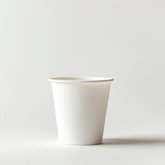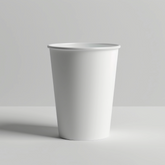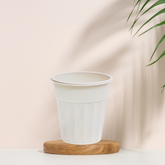Besoin d'aide ?
Si vous avez d'autres questions, contactez-nous à contact@g4earth.com
Questions les plus fréquentes
Un plastique bio-sourcé est fabriqué à partir de matières premières biologiques, comme des plantes (manioc, canne à sucre, maïs) ou des déchets organiques, contrairement aux plastiques conventionnels qui utilisent des combustibles fossiles (pétrole, gaz de schiste). Par exemple, le bio-PET est un plastique bio-sourcé dérivé de la canne à sucre. Cependant, le terme "bio-sourcé" ne garantit pas que le plastique est biodégradable : certains plastiques bio-sourcés (comme le bio-PET) ont les mêmes propriétés que leurs équivalents fossiles et nécessitent un recyclage spécifique. En revanche, des matériaux comme la bagasse ou le tapioca, utilisés pour nos lunch boxes et bouteilles, sont à la fois bio-sourcés et biodégradables.
Source : Ellen MacArthur Foundation, The New Plastics Economy: Rethinking the Future of Plastics, 2016.
Plastique bio-sourcé : Fait référence à l’origine de la matière première (biologique plutôt que fossile). Par exemple, une bouteille en bio-PET est bio-sourcée mais pas biodégradable.
Plastique biodégradable : Fait référence à la fin de vie du produit, c’est-à-dire sa capacité à se décomposer naturellement en éléments non toxiques grâce à des micro-organismes. Par exemple, nos produits en bagasse et nos bouteilles en tapioca sont biodégradables et compostables à la maison. Certains plastiques, comme le PLA (acide polylactique), sont à la fois bio-sourcés et biodégradables, mais leur décomposition nécessite souvent des conditions industrielles (température élevée, humidité contrôlée), ce qui les rend moins pratiques pour un compost domestique.
Source : European Bioplastics, Bioplastics – Facts and Figures, 2023.
Les plastiques à usage unique (bouteilles, emballages, couverts) ont un impact environnemental majeur :
-
Pollution durable : Ils mettent des centaines d’années à se dégrader, s’accumulant dans les océans (8 millions de tonnes par an selon Ocean Conservancy, 2021).
-
Microplastiques : Leur fragmentation génère des microplastiques, qui polluent les écosystèmes et s’infiltrent dans la chaîne alimentaire, affectant la faune et la santé humaine. Une étude de 2022 a détecté des microplastiques dans le sang humain (Environment International, 2022).
-
Empreinte carbone : Leur production émet des gaz à effet de serre (environ 2-3 kg CO₂ eq/kg pour le PET, selon l’Ademe, 2021).
-
Recyclage limité : Seulement 9 % des plastiques produits mondialement sont recyclés (OCDE, Global Plastics Outlook, 2022). Le reste est incinéré ou envoyé en décharge.
Les produits alternatifs aux plastiques Green 4 Earth sont compostables et ne génèrent pas de microplastiques, contribuant à réduire ces impacts.
Les matériaux comme la bagasse (résidu de canne à sucre) et le tapioca (issu du manioc) offrent plusieurs avantages :
-
Renouvelables : Ce sont des sous-produits agricoles, réduisant la dépendance aux combustibles fossiles.
-
Biodégradables : Nos produits se décomposent en 3 à 6 mois dans un compost domestique, sans laisser de résidus toxiques.
-
Faible impact carbone : Leur production émet environ 0,5-0,8 kg CO₂ eq/kg (Ademe, 2021), contre 2-3 kg pour le PET.
-
Économie circulaire : Ils valorisent des déchets agricoles qui seraient autrement brûlés, réduisant les émissions (FAO, The State of Food and Agriculture, 2020).
Les matériaux comme la bagasse (résidu de canne à sucre) et le tapioca (issu du manioc) offrent plusieurs avantages :
-
Renouvelables : Ce sont des sous-produits agricoles, réduisant la dépendance aux combustibles fossiles.
-
Biodégradables : Nos produits se décomposent en 3 à 6 mois dans un compost domestique, sans laisser de résidus toxiques.
-
Faible impact carbone : Leur production émet environ 0,5-0,8 kg CO₂ eq/kg (Ademe, 2021), contre 2-3 kg pour le PET.
-
Économie circulaire : Ils valorisent des déchets agricoles qui seraient autrement brûlés, réduisant les émissions (FAO, The State of Food and Agriculture, 2020).
Les réglementations visent à réduire l’usage des plastiques à usage unique :
-
Directive européenne SUP (Single-Use Plastics) : Depuis 2021, elle interdit certains produits en plastique à usage unique (pailles, couverts, assiettes) et fixe des objectifs de réduction (ex. : 90 % de collecte des bouteilles plastiques d’ici 2029) (Directive UE 2019/904).
-
Loi AGEC (France) : La loi Anti-Gaspillage pour une Économie Circulaire cible l’élimination des plastiques à usage unique d’ici 2040, avec des mesures comme l’interdiction des emballages plastiques pour les fruits et légumes de moins de 1,5 kg depuis 2022 (Ministère de la Transition Écologique, 2023).
-
Objectifs de recyclage : Les bouteilles en plastique doivent contenir 30 % de plastique recyclé d’ici 2030 (Directive UE).
Ces lois encouragent l’adoption d’alternatives comme nos produits Green 4 Earth, qui répondent aux exigences réglementaires.
Une "fausse alternative" est un produit présenté comme écologique mais dont l’impact est similaire ou supérieur à celui du plastique qu’il remplace :
-
Substitutions inutiles : Remplacer un produit à usage unique par un autre produit à usage unique, même bio-sourcé, reste problématique (ex. : assiettes en PLA qui finissent en décharge faute de compostage industriel).
-
Greenwashing : Certains plastiques bio-sourcés (ex. : bio-PET) sont marketés comme "verts" mais ne sont pas biodégradables (Ellen MacArthur Foundation, 2016).
-
Nos produits sont conçus pour éviter ces pièges : biodégradables à la maison, issus de filières responsables, et alignés sur une véritable démarche RSE via notre label Green 4 Earth.
Voici quelques actions concrètes :
-
Privilégier le réutilisable : Utilisez des contenants durables.
-
Choisir des alternatives bio-sourcées : Optez pour nos produits bio-sourcés pour les usages à emporter.
-
Trier correctement : Déposez les plastiques recyclables dans les bacs adaptés et compostez nos produits biodégradables.
-
Soutenir des entreprises responsables : Privilégiez des marques engagées, comme notre start-up Green 4 Earth.
-
Sensibiliser : Encouragez votre entourage à réduire les plastiques à usage unique.
Source : Zero Waste France, Guide pour Réduire ses Déchets, 2023.
Nos produits offrent des avantages distincts par rapport au PLA :
-
Compostabilité domestique : Nos produits se décomposent en 3 à 6 mois dans un compost maison, tandis que le PLA nécessite un compostage industriel (European Bioplastics, 2023).
-
Impact environnemental : La culture de nos matériaux naturels nécessite une faible empreinte carbone. Le PLA peut nécessiter des cultures intensives.
-
Pas de confusion avec le recyclage : Le PLA complique les filières de recyclage, tandis que nos produits sont conçus pour être compostés directement.
Les microplastiques désignent des particules de plastique de dimensions inférieures à 5 millimètres, constituant une menace significative pour l’environnement et la santé humaine. Ces fragments proviennent soit de la dégradation progressive d’objets plastiques de plus grande taille – tels que bouteilles, emballages ou filets abandonnés –, soit de la production intentionnelle de particules minuscules, comme les microbilles intégrées dans certains produits cosmétiques ou industriels.
Leur omniprésence résulte de diverses sources : l’abrasion des pneus automobiles, le lavage de textiles synthétiques, ou encore la fragmentation des déchets plastiques sous l’effet des intempéries et des rayons ultraviolets. Une fois dispersés, les microplastiques s’infiltrent dans les écosystèmes terrestres et aquatiques, contaminant les sols, les rivières, et les océans. Leur petite taille facilite leur ingestion par la faune marine et terrestre, entraînant une bioaccumulation potentiellement toxique qui peut remonter jusqu’à la chaîne alimentaire humaine. De surcroît, ils ont la capacité d’adsorber des polluants chimiques, amplifiant ainsi leur impact nocif.
Contrairement aux matières organiques, les microplastiques ne se biodégradent pas : ils persistent dans l’environnement sous forme de particules toujours plus fines, résistant à la décomposition pendant des centaines, voire des milliers d’années. Cette durabilité, alliée à leur prolifération, en fait un défi environnemental majeur. Réduire leur usage, privilégier des matériaux biodégradables et renforcer les politiques de gestion des déchets sont autant de mesures essentielles pour enrayer ce fléau silencieux.
En résumé, les microplastiques incarnent une pollution insidieuse, dont les conséquences exigent une prise de conscience et une action collectives immédiates.
Comprendre les symboles
RECYCLAGE
Connu sous le nom de triangle de Möbius, il s'agit du symbole du recyclage, indiquant le processus à travers trois flèches :
- Tri des déchets
- Recyclage dans les usines de recyclage
- Fabrication et livraison sur le marché d'un nouveau produit
PET ou PETE
-
Description : ♳ Le PET est un plastique rigide et transparent, souvent utilisé pour les produits à usage unique. C'est l'un des plastiques les plus courants pour les emballages alimentaires.
-
Usages : Bouteilles d'eau, sodas, huiles alimentaires, plateaux repas, textiles (polyester).
-
Recyclabilité : Oui, le PET est largement recyclable. Il peut être transformé en rPET (PET recyclé) pour fabriquer de nouvelles bouteilles ou des fibres textiles (ex : polyester recyclé).
Environ 60 % des bouteilles en PET sont collectées pour le recyclage en Europe (PETcore Europe, 2023).
Impact environnemental :
- Production : Émet environ 2-3 kg CO₂ eq/kg (Ademe, 2021).
- Fin de vie : Non biodégradable, il peut persister des centaines d’années dans l’environnement s’il n’est pas recyclé, formant des microplastiques.
HDPE (Polyéthylène Haute Densité)
-
Symbole : ♴ HDPE
-
Description : Le HDPE est un plastique rigide, résistant et opaque, connu pour sa durabilité et sa capacité à être moulé facilement.
-
Usages : Bouteilles de lait, bidons de détergent, flacons de shampoing, tuyaux, jouets.
-
Recyclabilité : Oui, le HDPE est facilement recyclable. Il est souvent transformé en nouveaux contenants, tuyaux, ou meubles d’extérieur. Son taux de recyclage est relativement élevé grâce à sa facilité de tri (environ 30-40 % en Europe, selon PlasticsEurope, 2023).
Impact environnemental :
- Production : Émet environ 2 kg CO₂ eq/kg (Ademe, 2021).
- Fin de vie : Non biodégradable, il contribue à la pollution plastique s’il n’est pas recyclé. Cependant, sa robustesse permet souvent plusieurs cycles de recyclage.
V ou PVC (Polychlorure de Vinyle)
-
Symbole : ♵ V ou PVC
-
Description : Le PVC est un plastique rigide ou souple (selon les additifs), connu pour sa durabilité et sa résistance aux intempéries.
-
Usages : Tuyaux, fenêtres, revêtements de sol, câbles électriques, vêtements imperméables (PVC souple).
-
Recyclabilité : Oui, mais limitée. Le PVC est difficile à recycler car il contient souvent des additifs toxiques (ex. : phtalates, plomb), ce qui complique le processus. En Europe, environ 20 % du PVC est recyclé, principalement dans le secteur de la construction (VinylPlus, 2023).
-
Impact environnemental :
-
Production : Émet environ 2,5 kg CO₂ eq/kg et peut libérer des substances toxiques lors de sa fabrication (Ademe, 2021).
-
Fin de vie : Non biodégradable, il pose des problèmes environnementaux majeurs, notamment à cause des additifs qui peuvent se disperser dans l’environnement. L’incinération du PVC libère des dioxines, des composés cancérigènes (Greenpeace, 2020).
LDPE (Polyéthylène Basse Densité)
-
Symbole : ♶ LDPE
-
Description : Le LDPE est un plastique souple et flexible, souvent utilisé pour des applications nécessitant une certaine élasticité.
-
Usages : Sacs plastiques, films d’emballage (ex. : film alimentaire), sacs poubelle, doublures de cartons.
-
Recyclabilité : Oui, mais difficile. Le LDPE est recyclable, mais son format (films fins) complique le tri et le nettoyage, entraînant un faible taux de recyclage (environ 10 % en Europe, selon PlasticsEurope, 2023). Il est souvent transformé en granulés pour fabriquer de nouveaux films ou des sacs poubelle.
-
Impact environnemental :
-
Production : Émet environ 2 kg CO₂ eq/kg (Ademe, 2021).
-
Fin de vie : Non biodégradable, il est particulièrement problématique sous forme de sacs plastiques, qui polluent les océans et les écosystèmes (Ocean Conservancy, 2021).
PP (Polypropylène)
-
Symbole : ♷ PP
-
Description : Le PP est un plastique rigide et résistant, apprécié pour sa capacité à supporter des températures élevées.
-
Usages : Pots de yaourt, bouchons de bouteilles, contenants alimentaires, boîtes de rangement, cordes.
-
Recyclabilité : Oui, le PP est recyclable et souvent transformé en nouveaux contenants, meubles d’extérieur ou pièces automobiles. Son taux de recyclage est modéré (environ 20 % en Europe, selon PlasticsEurope, 2023).
-
Impact environnemental :
-
Production : Émet environ 2 kg CO₂ eq/kg (Ademe, 2021).
-
Fin de vie : Non biodégradable, il contribue à la pollution plastique s’il n’est pas recyclé. Cependant, sa durabilité permet plusieurs cycles de recyclage.
PS (Polystyrène)
-
Symbole : ♸ PS
-
Description : Le PS existe sous deux formes : rigide (transparent) ou expansé (mousse légère, comme le polystyrène).
-
Usages : Gobelets, plateaux alimentaires, emballages de protection (PS expansé), boîtes de CD (PS rigide).
-
Recyclabilité : Oui, mais très limitée. Le PS est difficile à recycler à cause de sa légèreté (surtout pour le PS expansé) et de sa contamination fréquente par des résidus alimentaires. Son taux de recyclage est inférieur à 5 % en Europe (PlasticsEurope, 2023).
-
Impact environnemental :
-
Production : Émet environ 2,5 kg CO₂ eq/kg (Ademe, 2021).
-
Fin de vie : Non biodégradable, il se fragmente facilement en microplastiques, notamment sous forme expansée, polluant les écosystèmes (Ocean Conservancy, 2021).
OTHER (Autres plastiques)
-
Symbole : ♹ OTHER
-
Description : Cette catégorie regroupe tous les plastiques qui ne rentrent pas dans les catégories 1 à 6. Elle inclut des plastiques comme le polycarbonate (PC), l’ABS (acrylonitrile butadiène styrène), et certains plastiques bio-sourcés ou biodégradables comme le PLA (acide polylactique).
-
Usages : Biberons (PC), jouets (ABS), imprimantes 3D (PLA), pièces automobiles.
-
Recyclabilité : Variable, mais généralement faible. Certains plastiques (ex. : ABS) peuvent être recyclés dans des filières spécialisées, mais le taux est très bas (<5 %, PlasticsEurope, 2023). Le PLA est biodégradable (compost industriel), mais non recyclable dans les filières classiques, ce qui entraîne une confusion et un envoi fréquent en décharge (European Bioplastics, 2023).
-
Impact environnemental :
-
Production : Variable selon le type (ex. : PC émet environ 3 kg CO₂ eq/kg).
-
Fin de vie : La plupart ne sont pas biodégradables (sauf exceptions comme le PLA), contribuant à la pollution plastique s’ils ne sont pas correctement gérés. Le polycarbonate peut contenir du BPA, un perturbateur endocrinien (Greenpeace, 2020).








